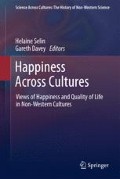Abstract
The Tibetan plateau, characterized by high altitude, long winters of extreme cold, and sparse vegetation is arguably among the harshest of populated terrains on the planet. Nonetheless, the Tibetan nomads have survived on the plateau for hundreds of years eking out a meager living predominantly as yak herders. Conditions in many of these high altitude areas have changed significantly over the past 15 years, shifting in countless respects the lifestyle of these nomadic people from livestock herding toward greater urbanization. While many have not been directly exposed personally to the teachings of Buddhism, their faith is strong. This accounts for a view of life that in the West would perhaps be described as happy and content. Working in the region over a period of about five years I was able to gain some insight in to what lay behind their happiness in spite of the great hardships they confronted daily. This chapter describes some of what I found.
Contentment is true wealth. Success will not be found through the gratification of desire, but in the end of desire—which is contentment. Wealthy is he who enjoys what he has.
Nagarjuna, Indian philosopher, 150–200 CE (Das 1997, p. 292)
Access this chapter
Tax calculation will be finalised at checkout
Purchases are for personal use only
Notes
- 1.
Interested readers can extend their understanding of the Buddhist concepts discussed in this chapter by referring to the many excellent books available. The Pabongka Rinpoche (2006) source cited here is an example of one such text. I have cited this text for many of the concepts discussed herein.
- 2.
See http://www.fpmt.org/projects/fpmt/seraje/263-life-in-sera-je-monastery.html plus also http://www.serajeymonastery.org/faculty.htm for more on this topic.
- 3.
This text is written in 24 sections with each section corresponding to a teaching day during which the referenced concepts were discussed. The reference Day can be regarded by the reader as a book chapter in the normal way.
- 4.
The honorific title ‘Rinpoche’ meaning ‘precious one (Tibetan)’ is usually given to a Lama who has intentionally taken rebirth in a human body to continue helping others. It is also a respectful title used for one’s own Lama (Lama Zopa Rinpoche 2008: 124).
References
Csikszentmihalyi, M. (1999). If we are so rich, why aren’t we happy? American Psychologist, 54(10), 821–827.
Csikszentmihalyi, M., & Rochberg-Halton, E. (1981). The meaning of things: Domestic symbols and the self. Cambridge: Cambridge University Press.
Cummins, R. A., Eckersley, R., Pallant, J., Van Vugt, J., & Misajon, R. (2003). Developing a national index of subjective well being: The Australian unity well-being index. Social Indicators Research, 64(2), 159–190.
Cummins, R. A., Lau, A. L. D., Mellor, D., & Stokes, M. A. (2009). Encouraging governments to enhance the happiness of their nation: Step 1: Understand subjective well being. Social Indicators Research, 91(1), 23–36.
Das, L. S. (1997). Eight steps to enlightenment. Awakening the Buddha within. Tibetan wisdom for the western world. Sydney: Bantam Books.
Festinger, L. (1957). A theory of cognitive dissonance. Evanston, IL: Row, Peterson.
Gyatso, T., (His Holiness the Dalai Lama) (1982). Happiness, karma and mind: Second dharma celebration. Dharamsala, India: Tushita Mahayana Meditation Centre. http://www.lamayeshe.com/index.php?sect=article&id=413. Accessed February 21, 2011.
His Holiness the Dalai Lama & Cutler, Howard, C. (1998). The art of happiness: A handbook for living. Sydney: Hodder Headline.
International Wellbeing Group. (2006). Personal well-being index. Deakin University: Australian Centre on Quality of Life. http://www.deakin.edu.au/research/acqol/index.php. Last accessed April 25, 2011.
Kahnemann, D., Diener, E., & Schwarz, N. (1999). Well-being: The foundations of hedonic psychology. New York: Russell Sage Foundation.
Lama Zopa Rinpoche. (2008). How things exist: Teachings on emptiness. Boston: Lama Yeshe Wisdom Archive.
Lau, A. L. D., Cummins, R. A., & McPherson, W. (2005). An investigation into the cross-cultural equivalence of the personal well-being index. Social Indicators Research, 72(3), 403–430.
Pabongka Rinpoche. (2006). Liberation in the palm of your hand: A concise discourse on the path to enlightenment (Revised ed.). Boston: Wisdom Publications.
Sera Je Monastery http://www.serajeymonastery.org/faculty.htm. Last accessed April 25, 2011.
Shantideva (2006). The way of the Boddhisattva: A translation of the Bodhicharyavatara (Revised ed.). Boston and London: Shambala Classics.
Webb, D. A. (2009). Subjective well-being on the Tibetan plateau: An exploratory investigation. Journal of Happiness Studies, 10(6), 753–768.
Webb, D. A., & Stuart, K. (2007). Exploring the impact of providing alternative technology products in remote Tibetan communities. Journal of Research for Consumers (http://www.jrconsumers.com), Issue 12.
Yushu Earthquake Relief. (2010). Timeline of events, http://en.wikipedia.org/wiki/2010_Yushu_earthquake. Last accessed April 25, 2011.
Acknowledgements
The author gratefully acknowledges Norman Leslie (Edith Cowan University) for providing permission to publish the photographs included in this chapter.
Author information
Authors and Affiliations
Corresponding author
Editor information
Editors and Affiliations
Rights and permissions
Copyright information
© 2012 Springer Science+Business Media B.V.
About this chapter
Cite this chapter
Webb, D. (2012). Happiness on the Tibetan Plateau. In: Selin, H., Davey, G. (eds) Happiness Across Cultures. Science Across Cultures: the History of Non-Western Science, vol 6. Springer, Dordrecht. https://doi.org/10.1007/978-94-007-2700-7_3
Download citation
DOI: https://doi.org/10.1007/978-94-007-2700-7_3
Published:
Publisher Name: Springer, Dordrecht
Print ISBN: 978-94-007-2699-4
Online ISBN: 978-94-007-2700-7
eBook Packages: Humanities, Social Sciences and LawLiterature, Cultural and Media Studies (R0)

